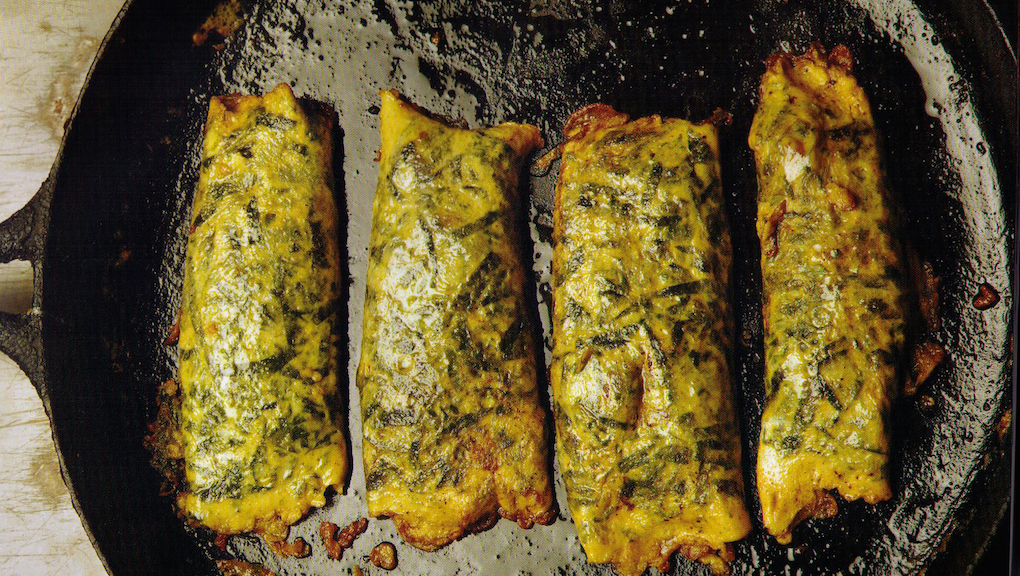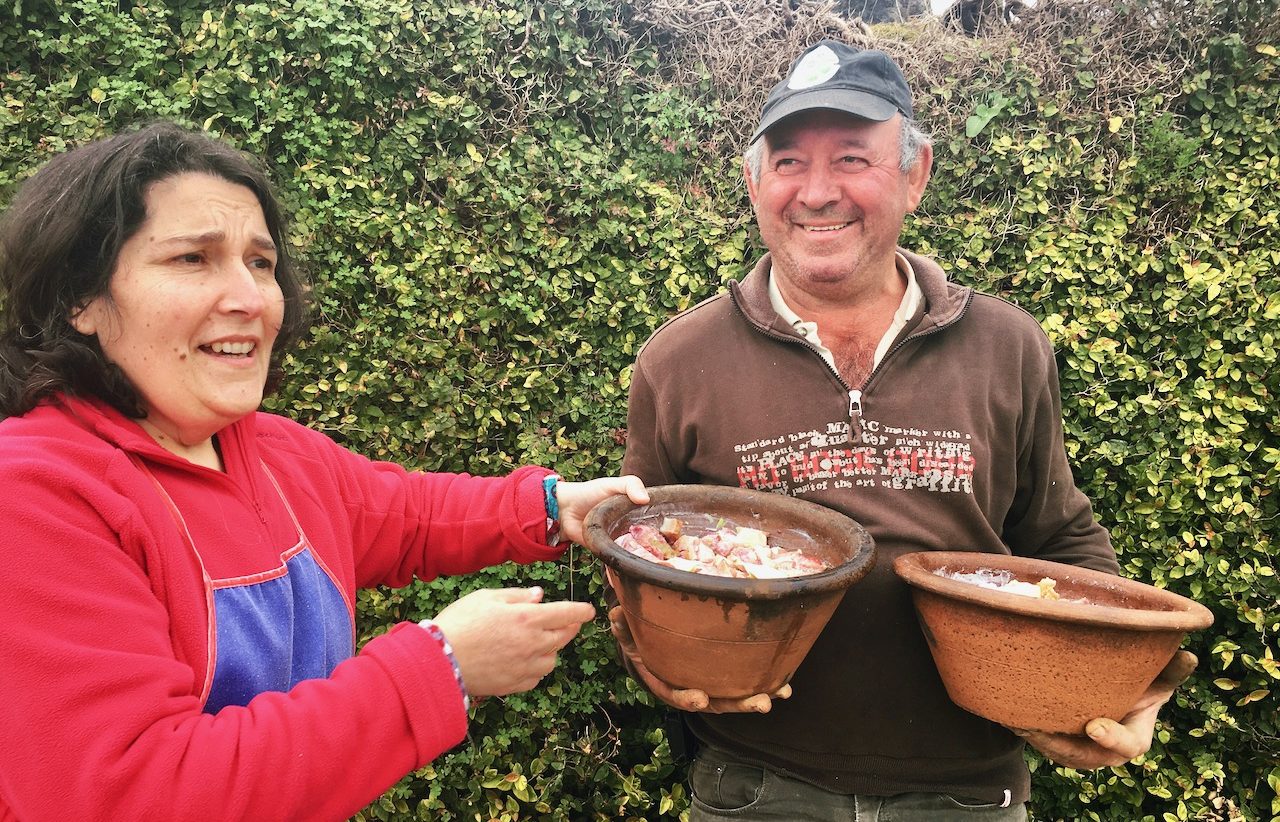AZORES FOOD AND WINE GUIDE
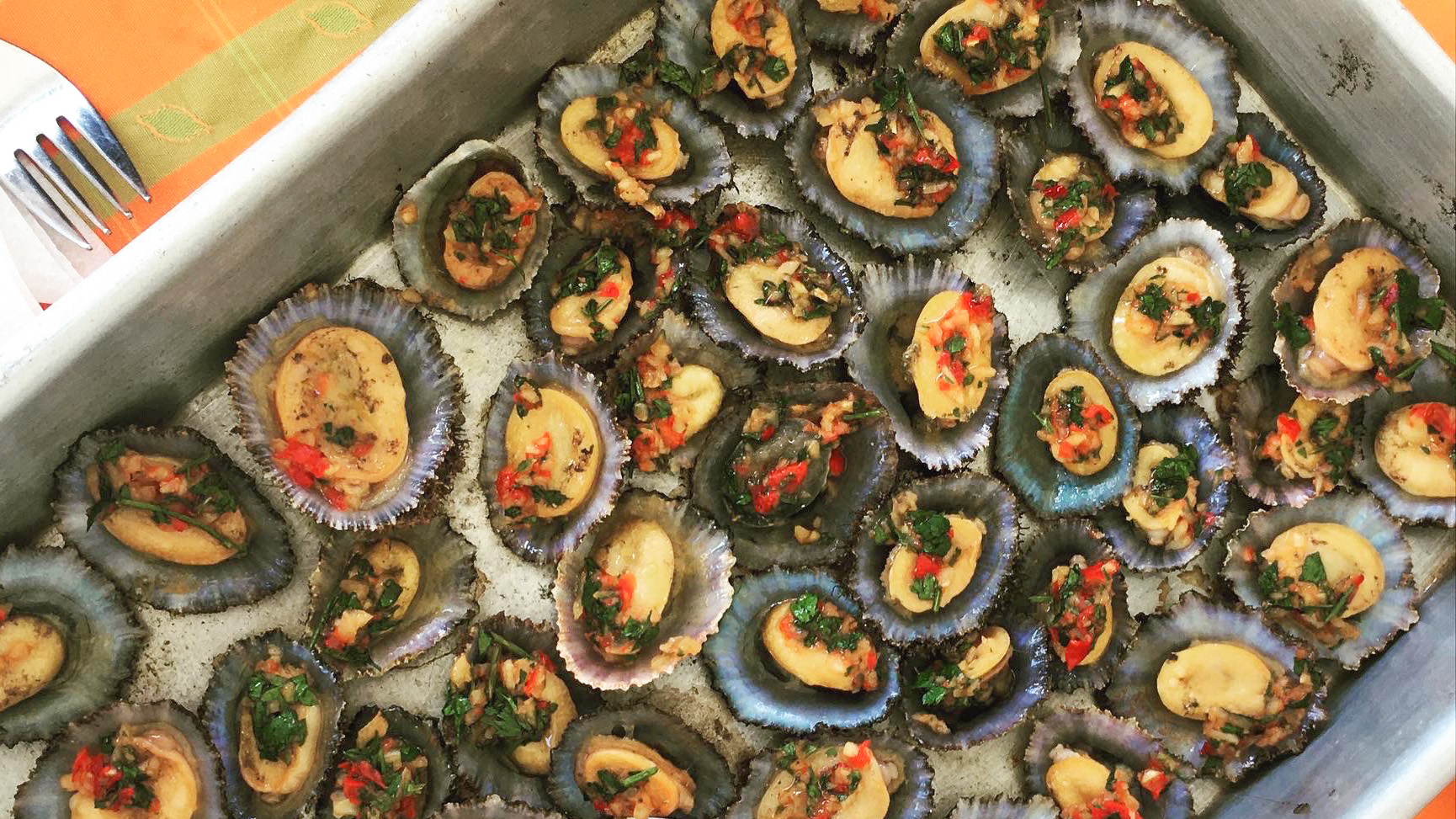
The Azores are mostly known as a nature and adventure destination but, in recent years, Azorean gastronomy and wines are finally getting international recognition and thus motivating food lovers to put these Portuguese islands in their travel wishlist. Oh! My Cod Pico Experience is a great example of that.
The archipelago of the Azores is made up of nine islands in the Atlantic ocean, one third off the coast of Portugal, and about two thirds to the United States. This strategic position, paired with the unique topographic and weather conditions and particular history of each island, gave birth to a cuisine that breathes lots of influences from mainland Portugal, but that does have its own unique cooking techniques, dishes, and ingredients with a touch of exotism the mainland’s climate wouldn’t be conducive to.
What to eat and drink in the Azores Islands?
When it comes to food, the Azores are pretty self-sufficient. Even though products from mainland Portugal and other countries do make it to supermarket shelves, mostly for the sake of variety, there is no shortage of food here. You will see cows grazing for dairy and beef, the temperatures and humidity are propitious for a good range of fruits and vegetables to grow and, being surrounded by the open water, fish and seafood also abound.
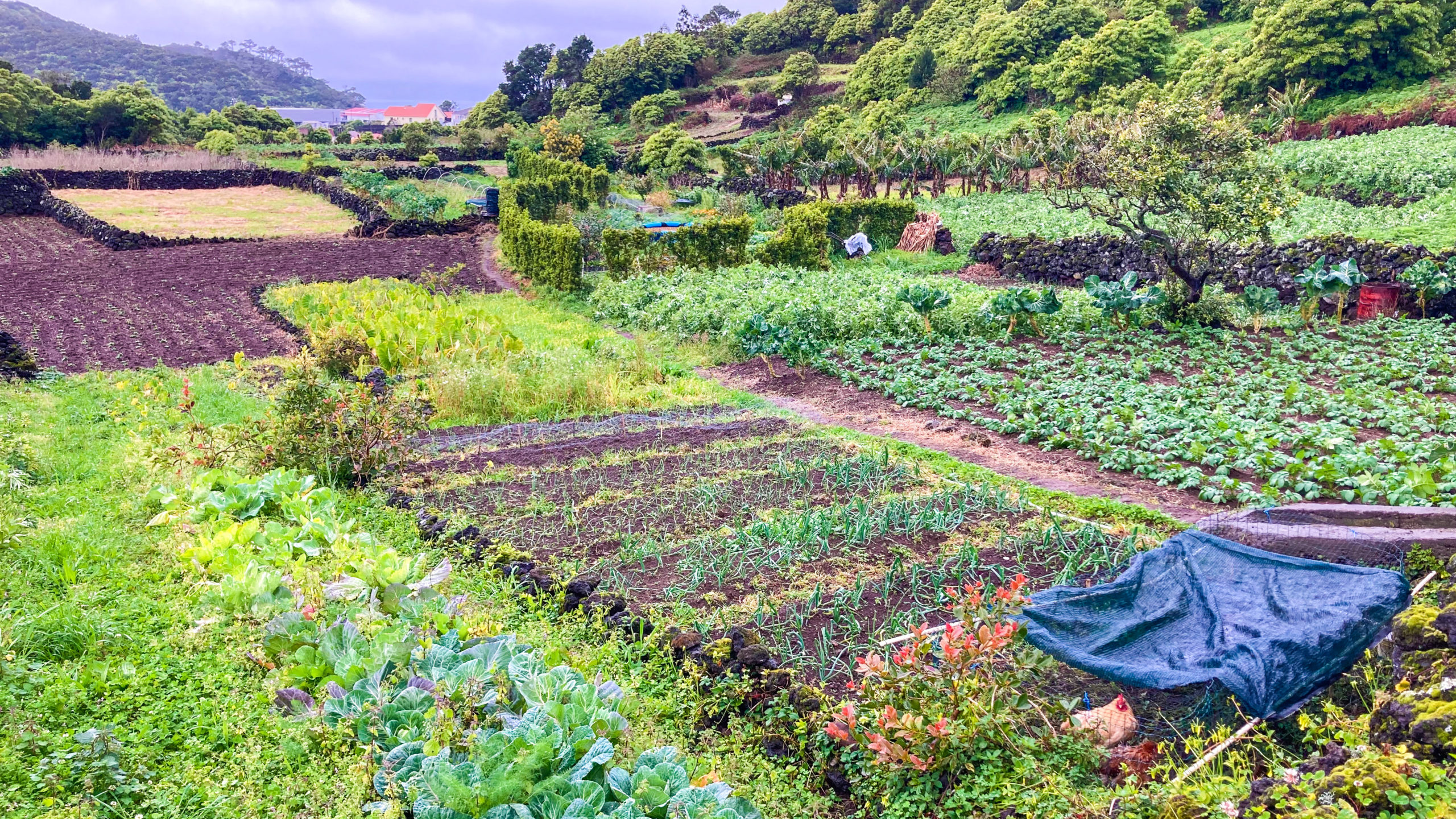
Even though you will find new restaurants with fusion cuisines and contemporary interpretations clearly breathing in international influences, traditionally speaking, food from the Azores is rooted in peasant cooking. This means, eating what the surroundings provide and making the most of available ingredients, specially via soups and hearty stews.
Visiting each island in the archipelago will give you the opportunity to sample new ingredients and recipes. These are some of the most representative foods and drinks you should try in the Azores.
Azores Seafood
Seafood in the Azores is incredibly diverse and varies seasonally. Situated in the middle of the Atlantic, these islands receive lots of species during their migrations between the Atlantic and the Caribbean. While some names will be familiar to international travelers, others will sound novel and are best appreciated if you trust the locals recommendations depending on the time of the year.
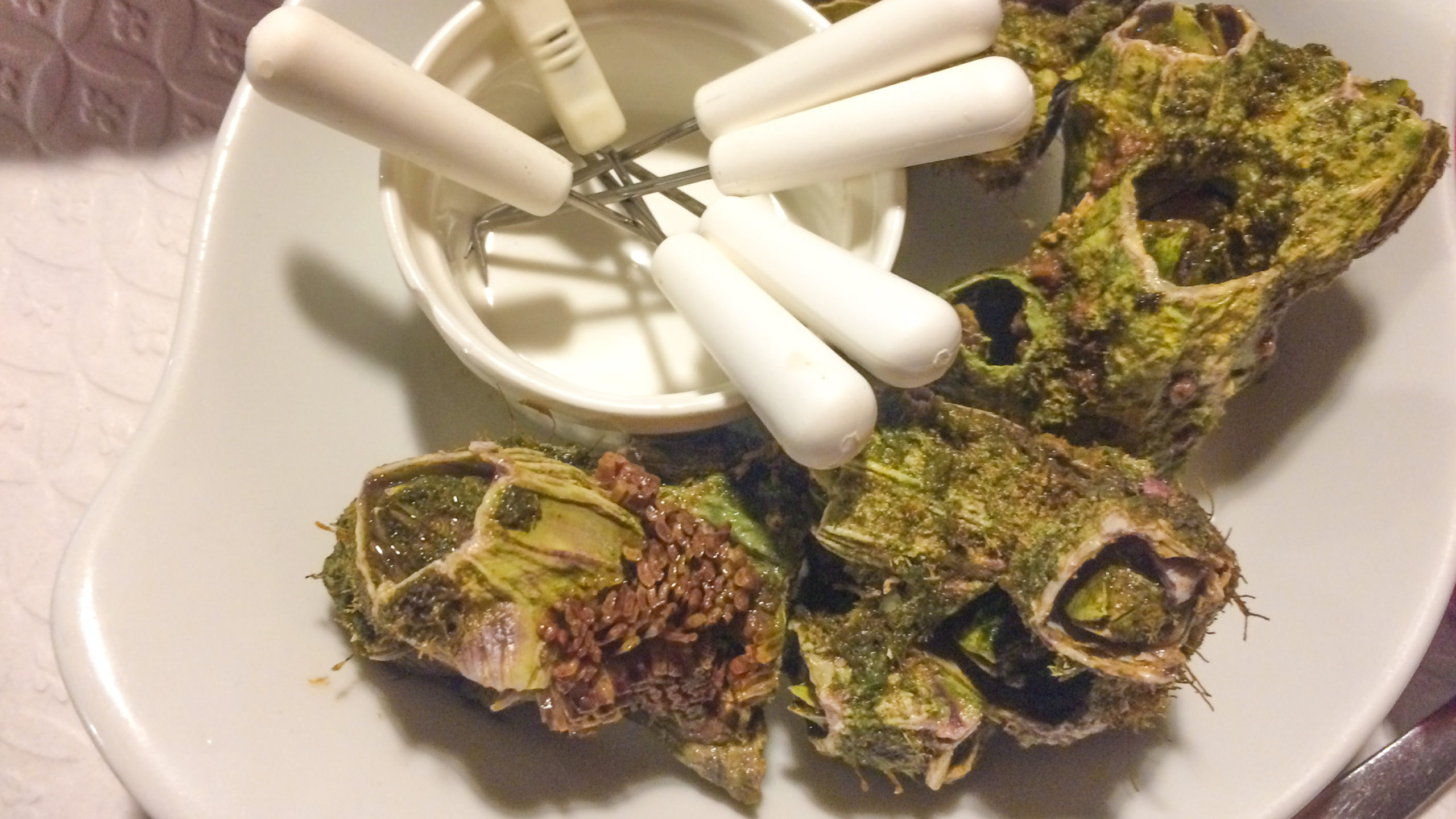
Cracas
Cracas are the Azorean relative of goose barnacles, shells that grow attached to rocks by the coast. They are considered a true delicacy, for their particular briny taste and also because they need to be caught by expert fishermen who freedive up to 10 meters to collect them. Cracas, known in English simply as barnacles, are boiled in seawater and served after coming down to room temperature. They are considered an appetizer, part of the Portuguese repertory of petiscos, particularly common in the late summer when they reach their peak of size, but generally available from April onwards.
Lapas
Limpets are mollusks usually found between June and September, which are traditionally eaten grilled and finished with a garlic butter sauce. The morsels of orange flesh are tucked inside a shell, which ends up being perfect to scoop the sauce. Like it happens with many Azorean dishes, the sauce for grilled limpets may also include some massa malagueta or pimenta da terra, a paste made with local chilies and salt, which is a true staple of Azorean cuisine.
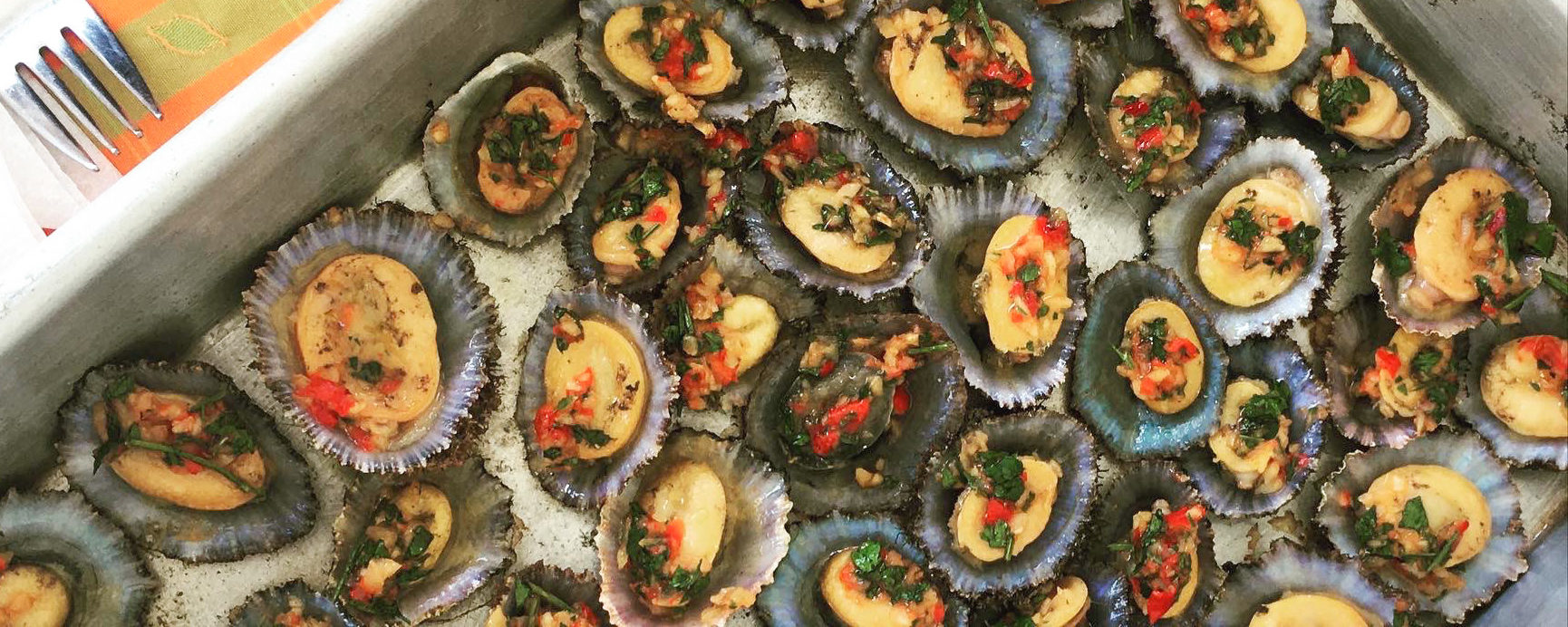
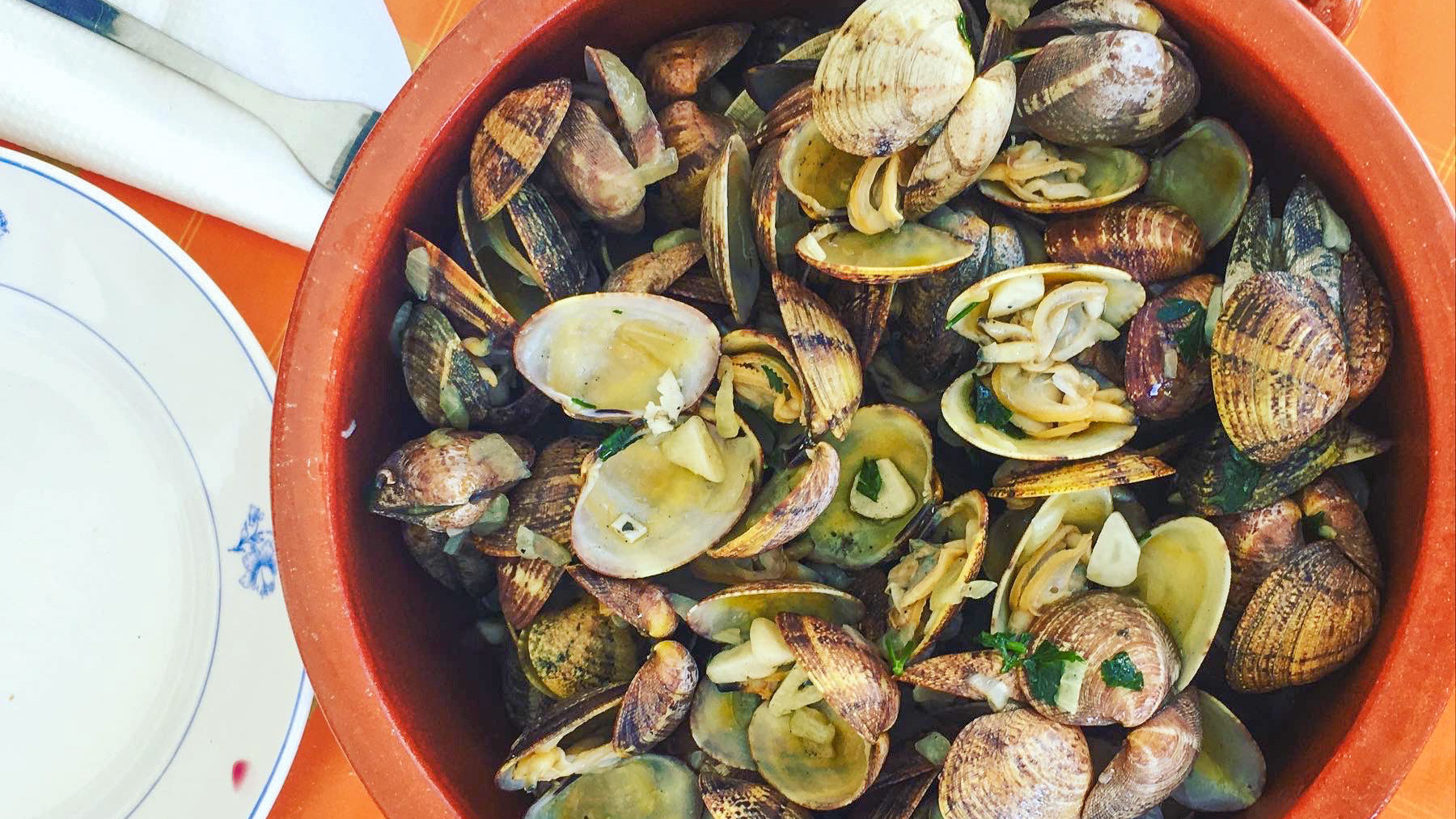
Giant clams from São Jorge
There are clams in many parts of Portugal and the world. But none compare to the giant clams which you will find in São Jorge,especially in Caldeira de Santo Cristo. In the Azores, the term Fajã refers to the land at the bottom of massive coastal cliffs that were created by lava flows. The lagoon at Fajã de Santo Cristo is the one and only place where these special giant clams grow, and to eat them you have to travel there! This highly appreciated delicacy is only available between mid May and mid August, and locals rave about their size, tenderness and flavor, only enhanced by a few ingredients such as onions, garlic, olive oil and fresh herbs.
[incredibly] fresh Azores fish
The waters surrounding the Azores are rich in fish species that you may not easily find elsewhere in the word, not even mainland Portugal. As such, if you are a seafood lover, traveling to the Azores is the perfect time to dedicate yourself to sampling different seafood dishes, from simple grills featuring the whole fish or slices of it, to fried fish, stews and soups, that take their flavor from the sea. Most fish preparations in the Azores are fairly simple and let the ingredients stand out for what they really are, particularly considering that utter most freshness is guaranteed around here. Grilled over charcoal, fishes like triggerfish, red bream, lookdown, blackbelly rosefish, greater amberjack, and greater forkbeard, tend to taste best.
Even though not native from the Azores, and not even from around the mainland, Portugal’s most beloved fish, salted cod, also features in the Azores recipe collection and it’s worth a quick mention. Bacalhau frito à moda dos Açores comprises fried cod filets, drenched in a sauce made with garlic, local chilies, tomato puree and olive oil, which is traditionally served with yams.
Chicharros fritos
If you prefer fish fried to golden perfection, don’t overlook chicharros fritos, a dish of deep-fried tiny blue mackerel, served with molho de vilão, a sauce named after the powers of villains because of its spiciness. If you prefer tart sauces over heat, you can also order chicharros with molho cru, which is a kind of salsa made with parsley, garlic, olive oil, vinegar, and just a hint of chili, which adds a lot of freshness and tang to the dish.
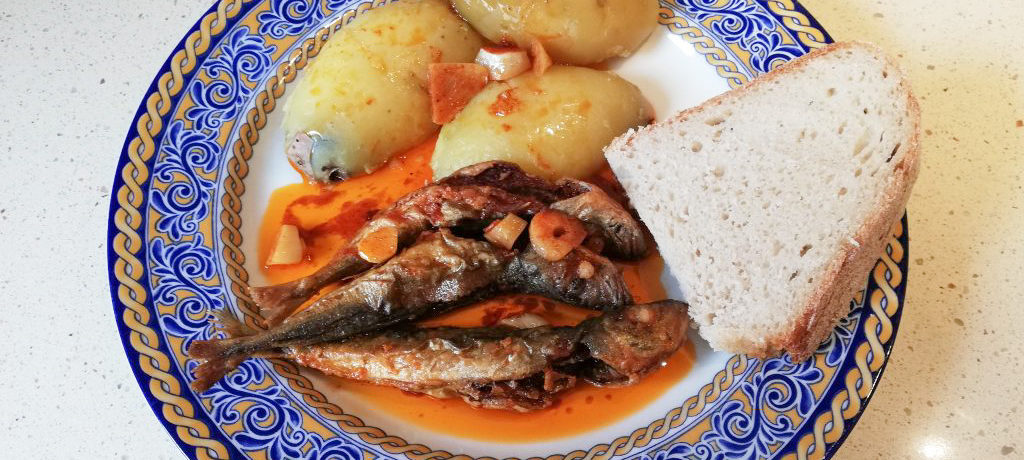
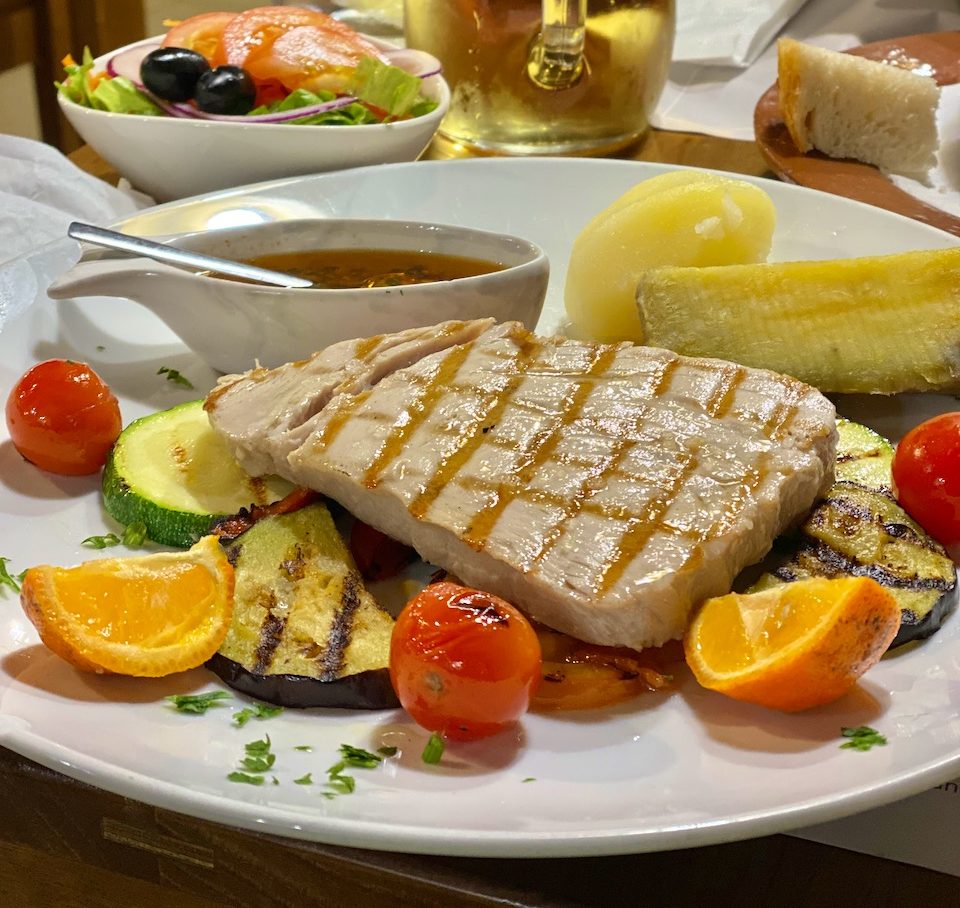
Azores tuna
Because not everything you eat in the Azores has to be novel, tuna is worth highlighting, as tuna steak is indeed one of the most popular and beloved meals in the islands, and even on mainland Portugal when you are lucky to visit one of the few Azorean restaurants we have access to. A good bife de atum is thick enough and doesn’t spend much time on the pan. You simply need to sear it briefly on each side, leaving the inside fleshy and intensely red, succulent and meaty. Thanks to volcanic activity, the temperature of the waters surrounding the islands of the Azores is ideal for tuna’s reproduction, thus explaining how prolific this species is in the region. Skipjack tuna is the most fished type of tuna around here, and it is worth mentioning that, keeping up with the sustainable fishing practices enforced in the Azores, tuna fishing is strictly done with pole and line. So when you eat tuna in the Azores, even the high quality canned tuna like the one by Azorean tuna factory Santa Catarina from São Jorge island, you can be rest assured that the fish is captured in a careful way that protects the marine ecosystem.
Caldo de peixe
One of the simplest, yet tastiest dishes in the Azores, goes by the name caldo de peixe, and consists of a preparation of assorted fish somewhere between a soup and a stew. This casserole brings together several species of fish, depending on the catch of the day, cooked in a rich sauce with onions, tomatoes, white wine, allspice and açaflor, an Azorean relative of saffron. Potatoes complete this dish, which is served following a specific ritual. While the entire cooking pot makes it to the table, the fish chunks are removed from it. On each plate, you serve a piece of each fish included in the recipe, as well as a whole potato, topped with molho cru verde, a fresh garlic and parsley salsa. The fish broth may sometimes be enjoyed in a separate bowl.
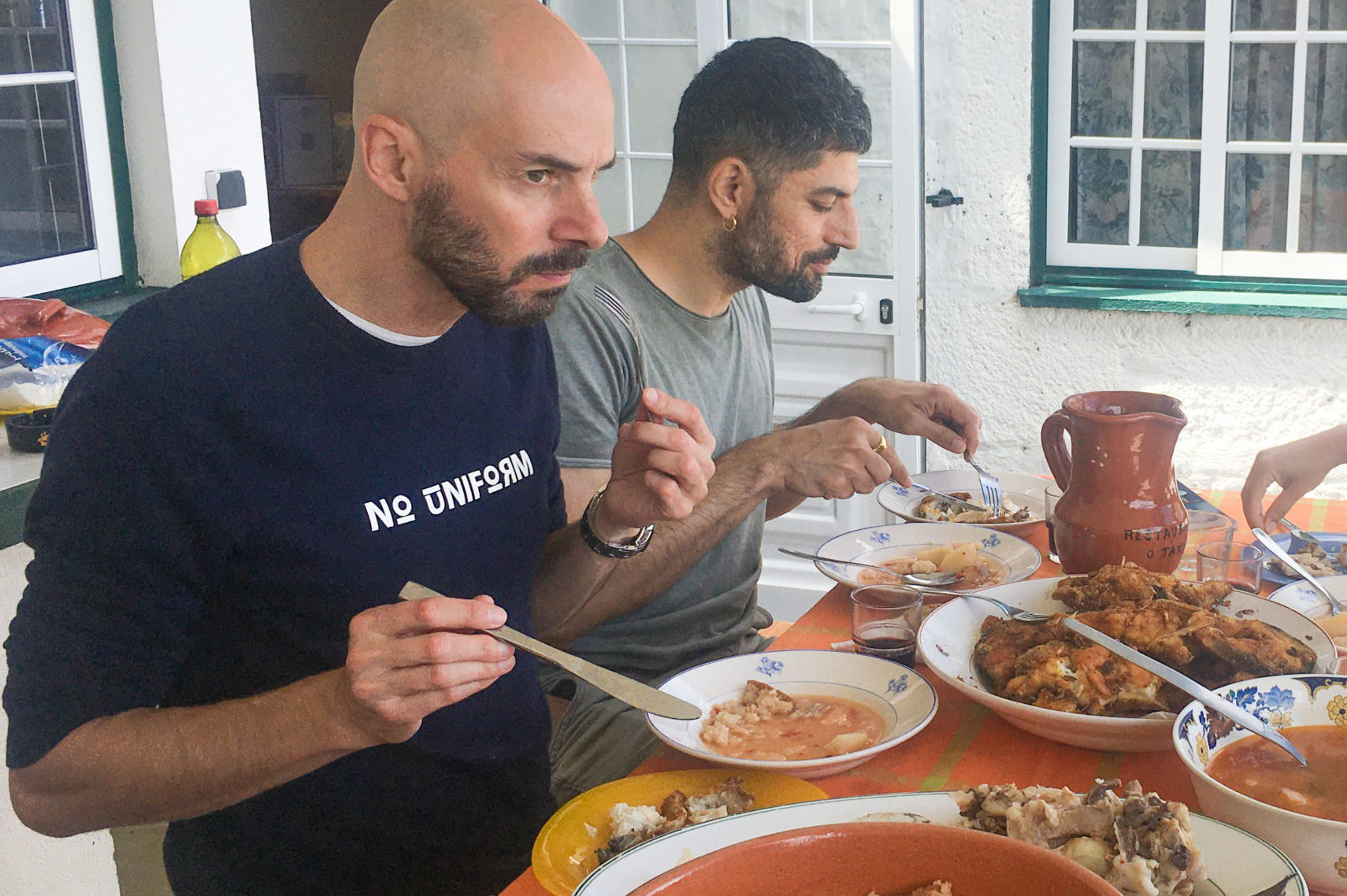
Polvo guisado
Guisado de polvo, that is, octopus stew, is one of the most iconic comfort foods from the Azores. Particularly relevant as one of the star dishes on Christmas Eve dinner, but also enjoyed all year long, this recipe also often goes by the name of polvo guisado à moda do Pico, as it is particularly popular in Pico and the neighboring island of Faial. The octopus pieces are cooked nice and slow in a generously condimented sauce with red wine, at the same time responsible for coloring and adding lots of flavor to the potatoes that accompany this dish.

Edible seaweed
Enjoying seafood doesn’t necessarily mean eating fish, shellfish, crustaceans or mollusks. Surrounded by the Atlantic ocean, the Azores are a great place where you can also taste recipes with algae, such as sea lettuce and kelp, or nori and wakame that have been taken mainstream by Japanese cuisine. Erva patinha, or Atlantic nori, is the most common seaweed used in traditional Azorean cooking, but it’s seasonal and it only abounds when heavy rains pair in perfect timing with cold days. When nature and the ocean are generous, locals collect erva patinha and cook it simply sauteed with garlic, olive oil and the local chili pepper pimenta da terra, or in the shape of tortas. Tortas de erva patinha, or tortas de erva calhau, particularly appreciated in the island of Corvo, are fritters made with seaweed, eggs and herbs, which can also be cooked with pork lard instead of vegetable oil, for extra flavor.
Azores Meat
 Azores PGI beef
Azores PGI beef
Beef from the Azores, known in Portuguese as Carne dos Açores PGI, refers to cattle that was born, raised and slaughtered in one of the nine islands, according to traditional methods. Unlike it happens in other parts of the world when it comes to animal farming, calves are fed with their mother’s milk until they are three months old. Afterwards, they graze naturally on the verdant Azorean pastures, even though their diets may be complemented with protein supplements. Because of the local flora and the natural way of life enjoyed by the cows, Azoren beef has a characteristic flavor and it’s renowned for its tender texture. Juicy steaks can be enjoyed all over the Azores, simply seasoned or with sauces that enhance the meat flavor. One of the most popular ways of enjoying beef is bife ã regional, a typical recipe originally from São Miguel, that brings together a steak cooked in a frying pan with butter, garlic, bayleaf and white wine, topped with a fried egg and pickled red peppers, with fries on the side.
Alcatra
Quite possibly Terceira island’s most notable dish, alcantra consists of a beef pot roast, more specifically made with rump (that’s what the word alcatra literally means in Portuguese), cooked inside a clay pot until the meat becomes ultra tender. This fall off the bone meat is seasoned with black pepper, onion, garlic and red wine. This iconic dish dates as far back as 1450, when the island of Terceira was first settled by people who came from the north and interior of Portugal, namely the regions of Trás-os-Montes and the Beiras, where a similar dish made with goat, chanfana, was also and still is a staple. Once a recipe only nobles would get to enjoy, alcatra has now become a mandatory dish for those exploring the gastronomy of the Azores, in particular of Terceira island.

Cozido das Furnas
If one of the most emblematic dishes in Portugal is cozido ã Portuguesa, its homonym in the island of São Miguel, and more specifically in the town of Furnas, is as remarkable and festive as they come. This Portuguese meat stew brings together several cuts of meats, including pork, beef, chicken, cured meats and sausages, along with vegetables like potatoes, cabbages and carrots. Instead of making use of a stove, in the town of Furnas, huge pots with the ingredients for cozido are buried near the bubbling volcanic hot spring pools, where they cook for about six hours. Not only is the way a cozido is cooked different (and more eco friendly!), in the Azores, the ingredients that make it to the pot are also particular. The beef here is of the highest quality, the regular potatoes are kept company with yams, and the cured meats and sausages are also distinct as every region of Portugal produces its own sausages with local variations of the ancient recipes of enchidos passed down from generation to generation. In the Azores, for example, blood sausage is different than in mainland Portugal, as besides the usual spices such as cumin and clove, it is also flavored with pimenta da terra and cinnamon, with a pronounced sweetish flavor.
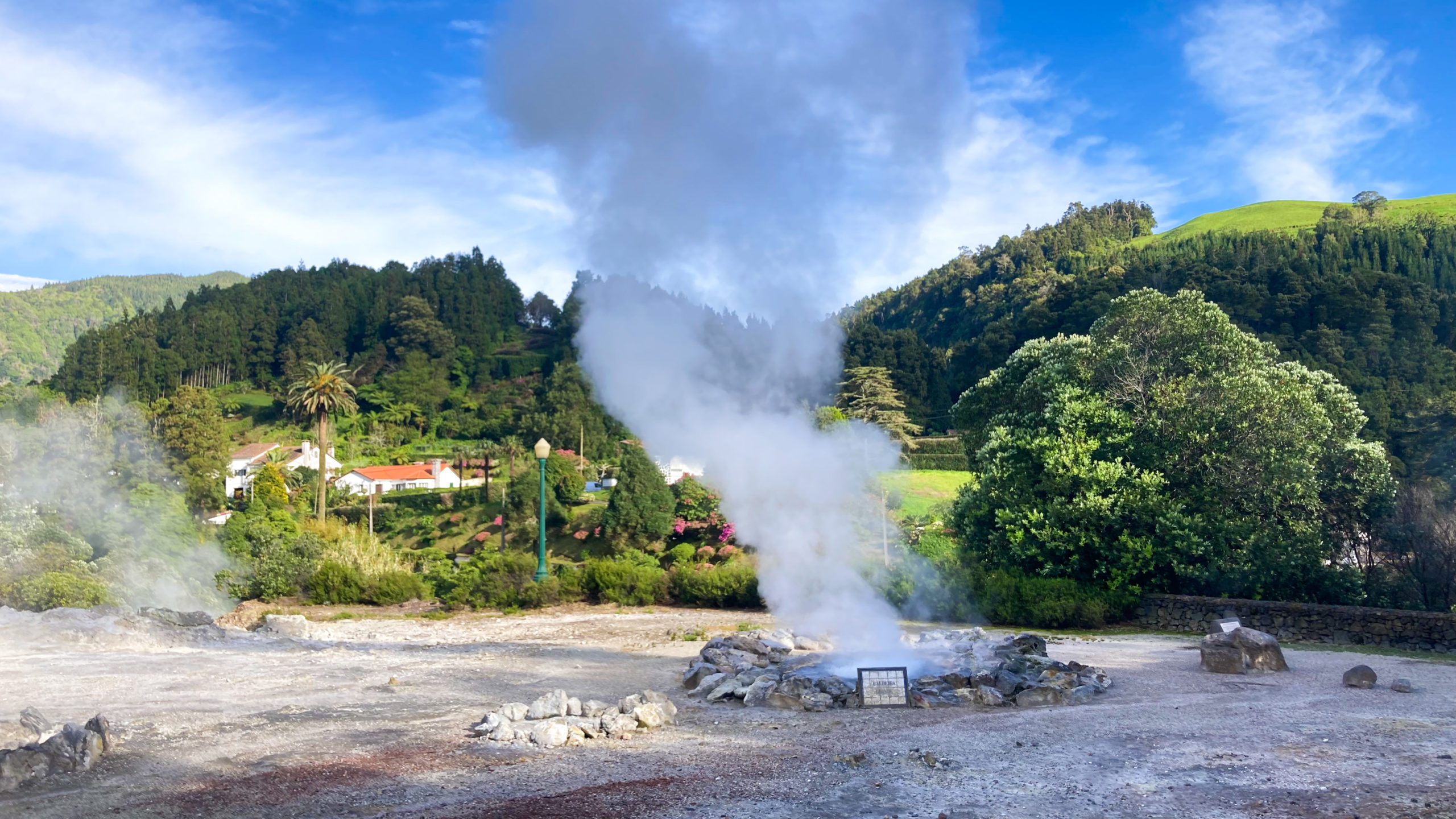
Molha de carne ã moda do Pico
Originally from Pico, but also typical in Faial, molha de carne is a recipe for tender and juicy meat that varies according to the cook and, even though it is in its vast majority prepared with beef, it can also sometimes feature pork meat. Because of the way the meat is cooked to potentiate its tenderness, molha de carne is often compared to alcatra, even though the cuts of beef for molha de carne include others than rump. For molha de carne the meat is cooked for about two hours in a sauce seasoned with onions, garlic, bay leaf, chili paste, parsley and wine, which will also serve as a flavor packed base to cook the potatoes in.
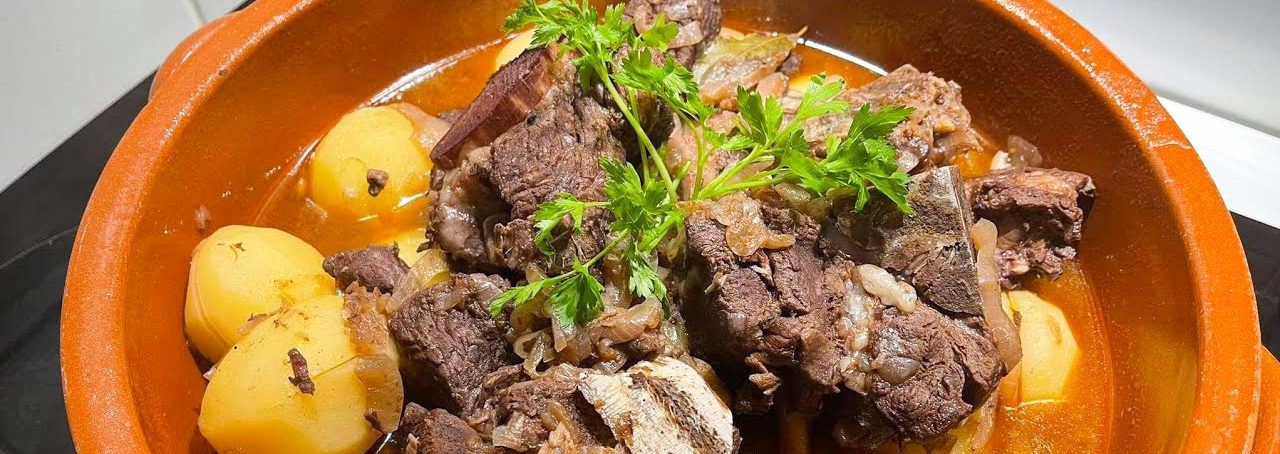
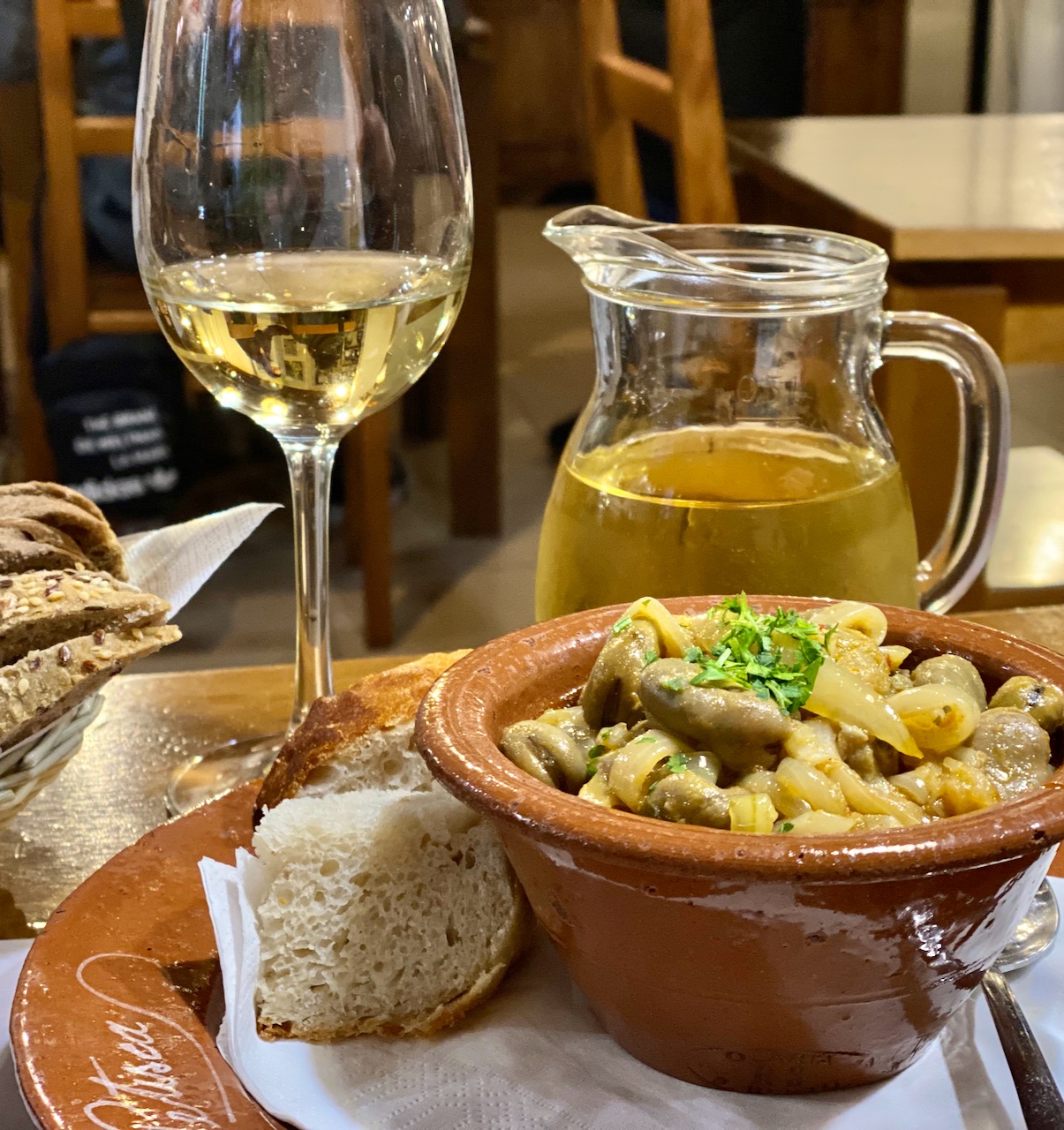
Fava bean stew
Broad bean stew, known locally as favas guisadas, is one of the rare vegetarian dishes you’ll commonly come across in the Azores, particularly in Terceira island. While in mainland Portugal this legume is often cooked with pork ribs or cured meats such as chouriço, in the Azorean kitchen there’s no need for meat to enhance the flavor of this hearty one pot dish cooked on a rich base of olive oil, garlic, plenty of onions and a tad of chili paste. Also known as favas escoadas, this is a perfect dish for bread dipping, and Azorean pão de milho, with a thick spongy crumb, is perfect to soak up the juices.
Sopas de Espãrito Santo
The Divine Holy Spirit is the most popular and traditional celebration in the Azores, which has extended even to North America, where a lot of Portuguese emigrants have settled over the last couple of generations. The Holy Spirit celebration spreads across several weeks, reaching its peak seven weeks after Easter Sunday. In good Portuguese fashion, celebrations are synonymous with special dishes, in this case, the Holy Ghost soup, a hearty dish meant for sharing, which you won’t usually find served anywhere during the rest of the year. When in the Azores someone speaks about sopas, without further details, chances are they are talking about this dish, and not about any other soup dish. Each serving of sopas consists of slices of buttered bread, which will be covered with the broth of cooking a mix of meats such as beef and chicken, boiled together with a blend of spices, collard greens and mint leaves for a touch of freshness. After comforting your stomach with the broth, it’s time to enjoy all the meaty and vegetable chunks that go into making this preparation, even though in some places they serve everything all together. No matter how you go about it, eating sopas do Espírito Santo is a tasty experience, but it’s also an anthropological one, as this is a dish very rich with flavor and history too!
Azorean cheeses and other dairy products
Ask anyone in mainland Portugal, and chances are they’ll tell you their favorite butter and cheese comes from the Azores. Making almost one third of the entire national production, dairy from the islands is incredibly popular and it’s a trade that has been perfected over 500 years, ever since the islands were first settled. Besides milk and delicious butter like our personal favorite Rainha do Pico, the world of queijos from the Azores is remarkable. The quality and flavors are distinctive and clearly influenced by the volcanic soil with rich pastures which serve as natural feed for the cows, and that translates into a particular taste of the milk.
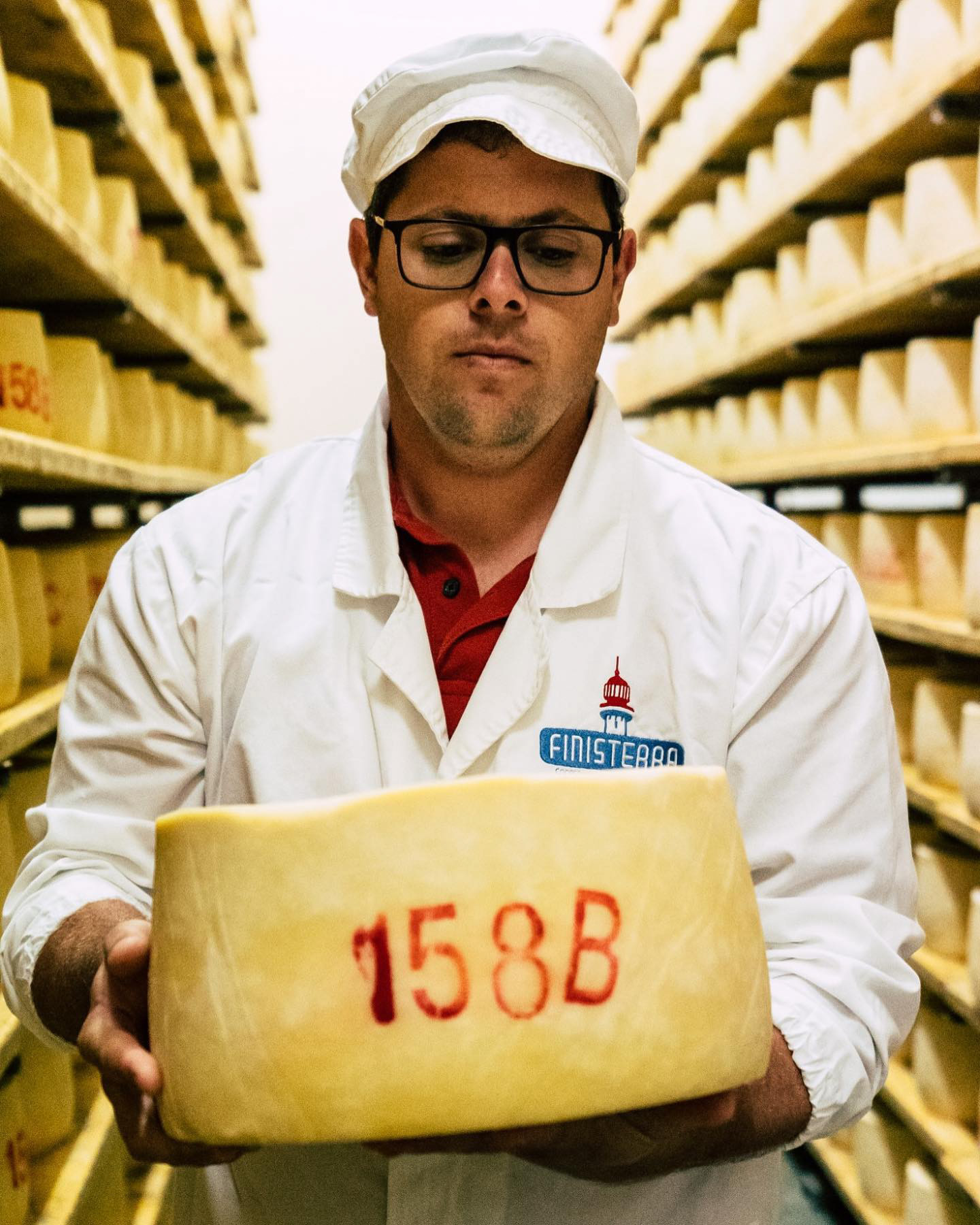 While dairy is to be found in virtually every island, from small artisanal producers to bigger companies catering to larger supermarkets, there are some cheeses that do stand out because of their unique characteristics and methods of production.
While dairy is to be found in virtually every island, from small artisanal producers to bigger companies catering to larger supermarkets, there are some cheeses that do stand out because of their unique characteristics and methods of production.
In São Jorge island we find the homonymous Queijo São Jorge, arguably the most renowned cheese from the Azores. It is a cured semi-hard to hard cheese, known for its sharpness and slightly spicy aftertaste. São Jorge cheese is made with fresh raw cow milk, curdled with rennet and compressed into round metal molds, to be aged for at least 90 days. PDO Queijo São Jorge is produced by three certified cheese factories on the island, with milk from over 200 dairy farmers. Not only is this one of Portugal’s favorite cheeses, often known simply as queijo da ilha, that is, island cheese, it is also responsible for almost 70% of the economy of the island, which has become synonymous with excellent cheese.
The island of Pico produces another PDO cheese, Queijo do Pico, with its origins dating back to the 18th century. The methods of production haven’t changed all that much ever since. With almost 50% fat, this is a soft buttery cheese with intense aroma and fairly salty taste. Its peculiar palate is also linked to the local flora of Pico, with plants such as ryegrass, pennywort and white-edged Swedish ivy making the majority of the cows diet. The wheels of cheese from Pico are smaller than those from São Jorge, and it’s only left to cure between 17 days and one month, resulting in a white paste with a yellowish rind.
Across from Pico stands the island of Faial, where Queijo O Morro is king. Even though itâs a young cheese as compared to those from Pico or São Jorge, with its production just having started in 2012, O Morro has been making the news and is now even exported to North America. More than a type of cheese, O Morro is a brand that focuses on a wide range of cheeses, from young to cured, being the soft buttery type, known in Portuguese as amanteigado de pasta mole, a best seller.
With slightly more cows than people, itâs no surprise dairy and cheeses can be found all over the Azores islands, but these are indeed the most celebrated. During our curated culinary trips to the Azores, we visit a cheese factory, so that we can get up close to how these cheeses are produced and who are the people who make it all happen.
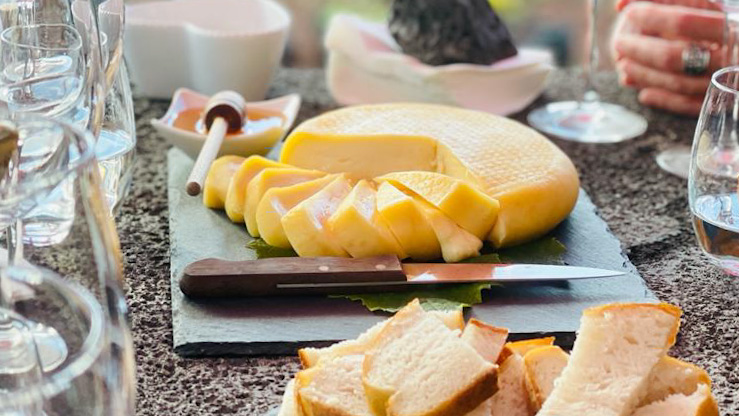
Sweet and savory baked goods from the Azores
Wherever you have good cheese, it’s a must to have good breads to match. When it comes to baked goods, the Azores deliver! Apart from being able to buy breads and cakes at regular supermarkets, artisanal bakeries and pastry shops are still common in the archipelago. Some of these small businesses are ideal to purchase breads that follow old traditional recipes, as well as typical sweets which tend to vary from island to island.
Massa sovada
Massa sovada, often referred to in English as Portuguese sweet bread or Azorean sweet bread, consists of a soft yeast dough made with milk, butter and eggs, somehow similar to a brioche. While it originated in São Miguel, the largest Azorean island, massa sovada is popular all over the archipelago and it is sometimes known as bolo das Festas do Espírito Santo, in reference to the Holy Spirit festivities when this bread is almost mandatory on a traditional table. In Terceira island, massa sovada is one of the most beloved side dishes for alcatra. Many would argue that cooking massava sovada in a wood oven takes it from good to great, while contributing to preserving Azorean culinary traditions too. Literally translating as ‘kneaded dough’, massa sovada is an edible testament to the community spirit often lived in small localities across the Azores, as it is a bread meant to be shared, particularly during festivities, where it often makes it to the table full, and it is cut piece by piece as folks around the table keep eating.
Bolo lêvedo
Those who travel to the island of São Miguel will easily get acquainted with bolo lêvedo, a slightly sweet soft bun reminiscent of an English muffin, used everywhere in the island, plain, on sandwiches and even to tuck burgers. Bolos lêvedos came about in the 19th century, at the Furnas valley, popular for its unique geothermal activity. Unlike other larger loaves of bread which would normally be cooked inside an oven, bolos lêvedos are shaped like small discs, heavily dusted with flour, and cooked on a stove top or metal grid, one side at a time. They taste beautiful fresh or even pressed or grilled in sandwiches with melted local Azores cheese.

Bolo de milho
 Bolo de milho or bolo da sertã, that is, griddle cake, is a flat corn bread from Pico island that became popular as a quick bread that didn’t require time to rise. When referred to as bolo do tijolo, this recipe is cooked on top of a brick (in Portuguese, tijolo), either inside the oven or on the stovetop. Bolo de milho, with one third of wheat and two thirds of corn, is thick and heavy, and tastes even better when butter or lard are added to its dough or, at least, to the pan where it’s cooked. It’s normally presented cut into triangles and it’s mandatory presence during a traditional meal in the island of Pico or as a part of a typical assorted bread basket from the Azores, which would also include pão de milho, corn bread, that despite its name, is a soft loaf of bread with a mix of wheat and corn flours, with a characteristic dark but soft exterior that gets its shine from egg wash.
Bolo de milho or bolo da sertã, that is, griddle cake, is a flat corn bread from Pico island that became popular as a quick bread that didn’t require time to rise. When referred to as bolo do tijolo, this recipe is cooked on top of a brick (in Portuguese, tijolo), either inside the oven or on the stovetop. Bolo de milho, with one third of wheat and two thirds of corn, is thick and heavy, and tastes even better when butter or lard are added to its dough or, at least, to the pan where it’s cooked. It’s normally presented cut into triangles and it’s mandatory presence during a traditional meal in the island of Pico or as a part of a typical assorted bread basket from the Azores, which would also include pão de milho, corn bread, that despite its name, is a soft loaf of bread with a mix of wheat and corn flours, with a characteristic dark but soft exterior that gets its shine from egg wash.
Espécies
Named after the amount of spices responsible for making these biscuits so fragrant, espécies are no doubt São Jorgeâs most famous sweet. Once upon a time made with lard, espécies are nowadays prepared with butter, sugar, breadcrumbs and a variety of aromatics such as cinnamon, fennel and allspice. The spice infused dough is shaped between a ring and a horseshoe, and covered in a different kind of richer white dough, which is cut in a way as to create little windows that show the dough underneath and that result in a catchy pattern that alternates brown and white. Espécies from São Jorge date as far back as the 15th century, when they were known as bichos doces, that is, sweet bugs. Sampling these confections nowadays is like tasting history!

Bolo Dona Amélia
Named after Queen D. Amélia, who visited Terceira island where these cakes are from in 1901, bolos Dona Amélia are an adaptation of the recipe for bolo das Índias, which already existed before the royalty inspired the name change. These heavily spiced pastries were popularized as sailors would come from overseas expeditions, bringing them with a variety of spices that were until then not common but were highly appreciated. Bolo Dona Amélia was initially a cake, as the name in Portuguese suggests, but eventually started being produced as individual confections, also known in Portuguese as queijadas. If you like sweets like gingerbread, you will appreciate Dona Ammélia’s smooth texture and its scents of cinnamon, nutmeg and molasses, complemented with raisins.

Queijadas
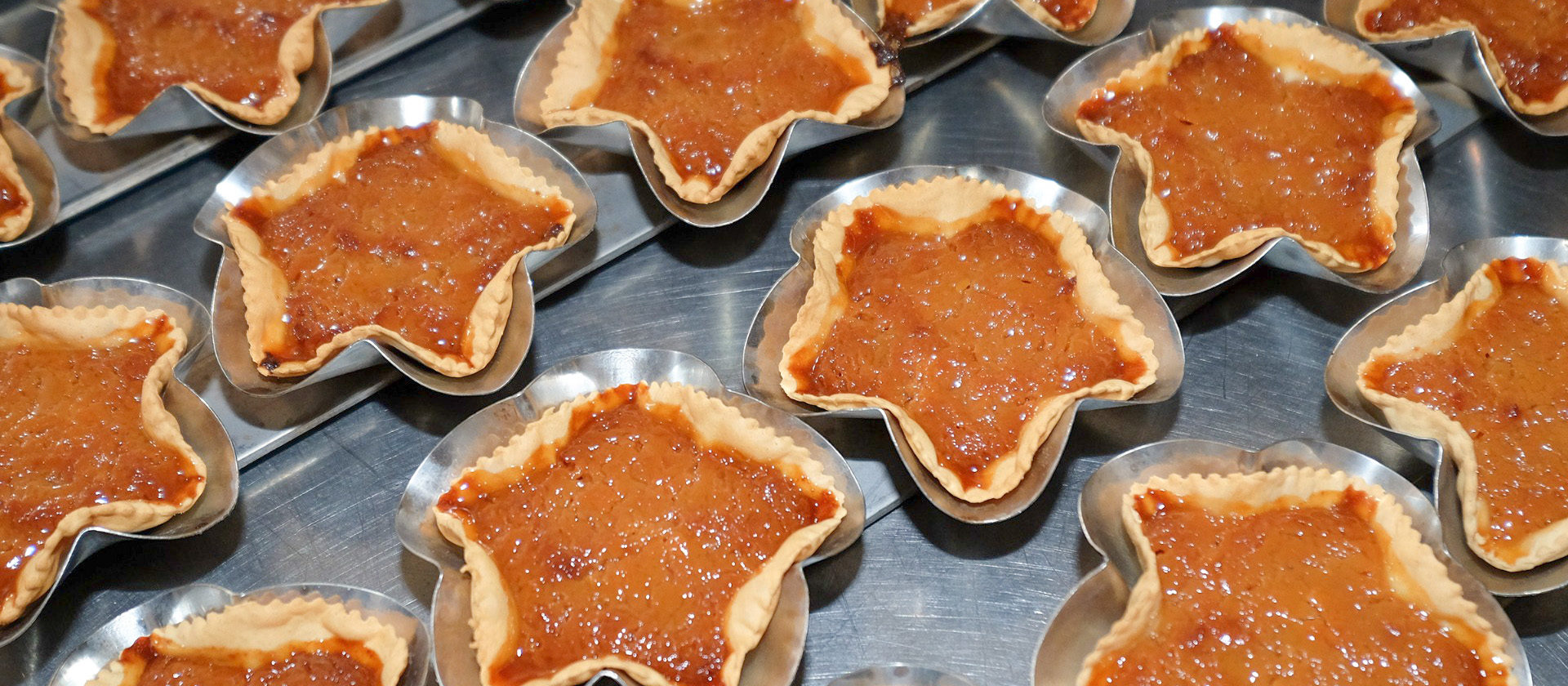 In Portuguese, queijada stands for cheesecake, but when you think of it you must not at all associate it with the international idea of baked cheesecake or New York cheesecake. Queijadas are individual portions of milky desserts, which may sometimes not even contain cheese, even though their name derives from the Portuguese words for cheese, queijo. Dairy will always be involved in the recipe, though, in the shape of milk, butter, or both. The Azores most popular queijadas include Queijadas de Vila Franca do Campo, from São Miguel, which are a conventual sweet with a smooth egg rich filling. Queijadas da Graciosa, from the island by the same name, are equally relevant in the Azorean sweets repertoire, combining a creamy filling with a crispy sugary crust. Queijadas are to the Azores what pastéis de nata are to Lisbon or even mainland Portugal: ubiquitous, beloved and, of course, super indulgent.
In Portuguese, queijada stands for cheesecake, but when you think of it you must not at all associate it with the international idea of baked cheesecake or New York cheesecake. Queijadas are individual portions of milky desserts, which may sometimes not even contain cheese, even though their name derives from the Portuguese words for cheese, queijo. Dairy will always be involved in the recipe, though, in the shape of milk, butter, or both. The Azores most popular queijadas include Queijadas de Vila Franca do Campo, from São Miguel, which are a conventual sweet with a smooth egg rich filling. Queijadas da Graciosa, from the island by the same name, are equally relevant in the Azorean sweets repertoire, combining a creamy filling with a crispy sugary crust. Queijadas are to the Azores what pastéis de nata are to Lisbon or even mainland Portugal: ubiquitous, beloved and, of course, super indulgent.
Exotic fruits
If the Azores is sometimes nicknamed ‘the Hawaii of Portugal’, we couldn’t celebrate the island’s subtropical climate without talking about the several types of exotic fruits grown here.
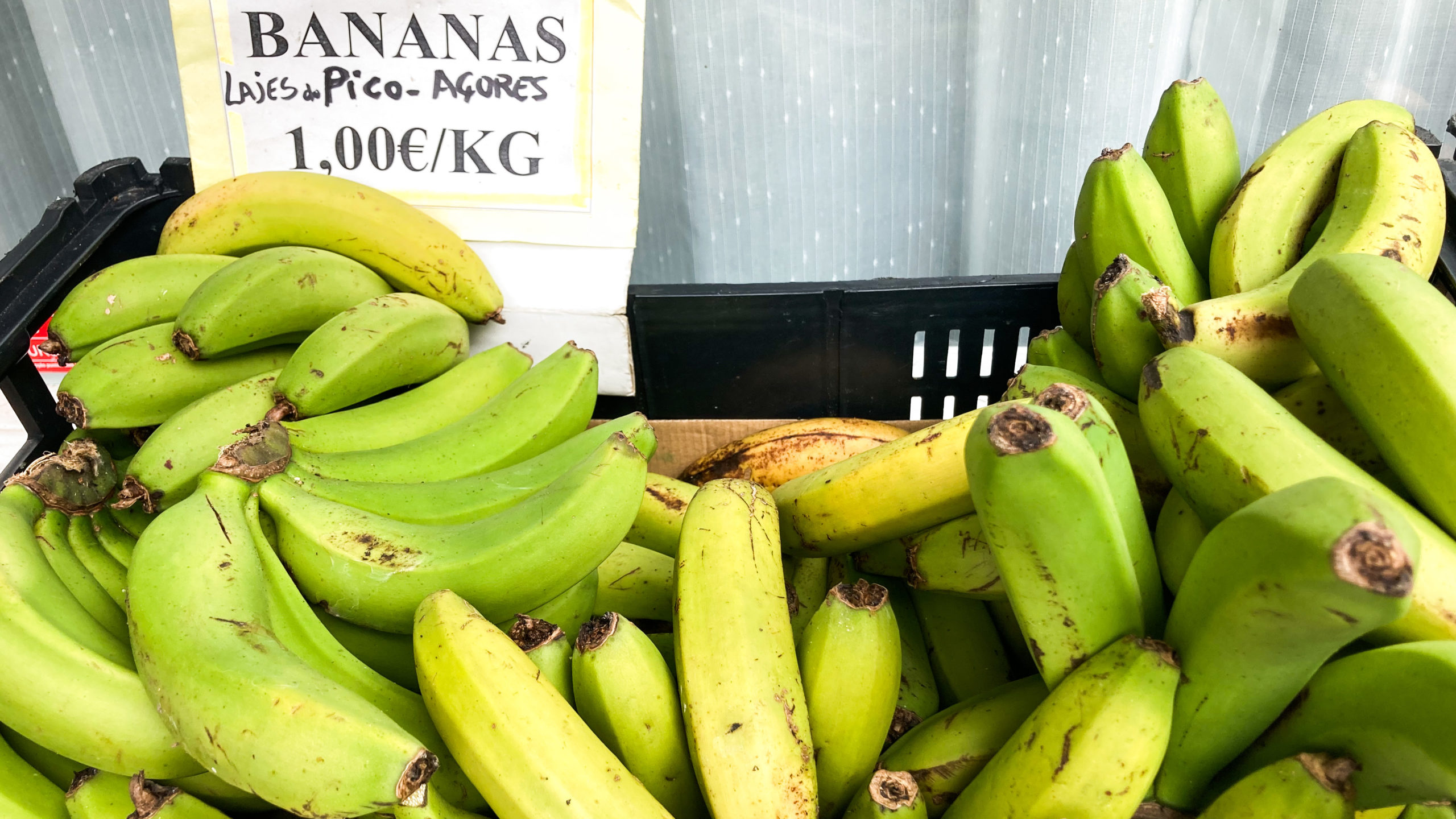 Even though the Portuguese island of Madeira is famous for its petite taste-concentrated bananas, the archipelago of the Azores also produces deep-flavored bananas, which don’t often make it to markets elsewhere. As such, it’s recommended to make the most of your time in the Azores, and sample this and other fruits grown here such as passion fruit, cherimoya and several kinds of guavas, including the locally known as araçá or lemon guava, which has a unique sweet and sour taste. While São Miguel where the capital of the Azores, Ponta Delgada, is located, leads on the production of many of these fruits, in the Triangle, Pico is famous for its volcanic lands that translate into delicious bounty, usually exported to the neighboring island of Fail to be sold at the farmer’s market in Horta.
Even though the Portuguese island of Madeira is famous for its petite taste-concentrated bananas, the archipelago of the Azores also produces deep-flavored bananas, which don’t often make it to markets elsewhere. As such, it’s recommended to make the most of your time in the Azores, and sample this and other fruits grown here such as passion fruit, cherimoya and several kinds of guavas, including the locally known as araçá or lemon guava, which has a unique sweet and sour taste. While São Miguel where the capital of the Azores, Ponta Delgada, is located, leads on the production of many of these fruits, in the Triangle, Pico is famous for its volcanic lands that translate into delicious bounty, usually exported to the neighboring island of Fail to be sold at the farmer’s market in Horta.
While also not native from the Azores, pineapples are one of the most iconic fruits grown in the Azores, specifically in the south of the island of São Miguel. Because pineapples are indeed a tropical species, in São Miguel they are cultivated inside traditional greenhouses, and this is the only place in the world where this fruit is actually grown in this manner. Even though this islandâs main crop was historically oranges, the production of this fruit stopped being relevant for the local economy after the world crisis of the 1870-90s. In the mid 19th century pineapples were introduced from Brazil and, even though they were initially cultivated as an ornamental crop, their production for food uses eventually caught on. When you visit a pineapple plantation in São Miguel and understand how much work goes into the production of one piece of fruit, and the fact that it takes two years for a pineapple to mature, chances are you’ll start savoring it in a more mindful way. Besides eating it fresh and noticing how the compact Azorian pineapples are much juicier and sweeter than your average pineapple, you can enjoy Azorean pineapples in different kinds of preparations, such as jam, chutney or liquor. Our favorite recipe brings together in one plate sweet pineapple with grilled blood pudding, morcela, in a combination that is bold, refreshing and very Portuguese.
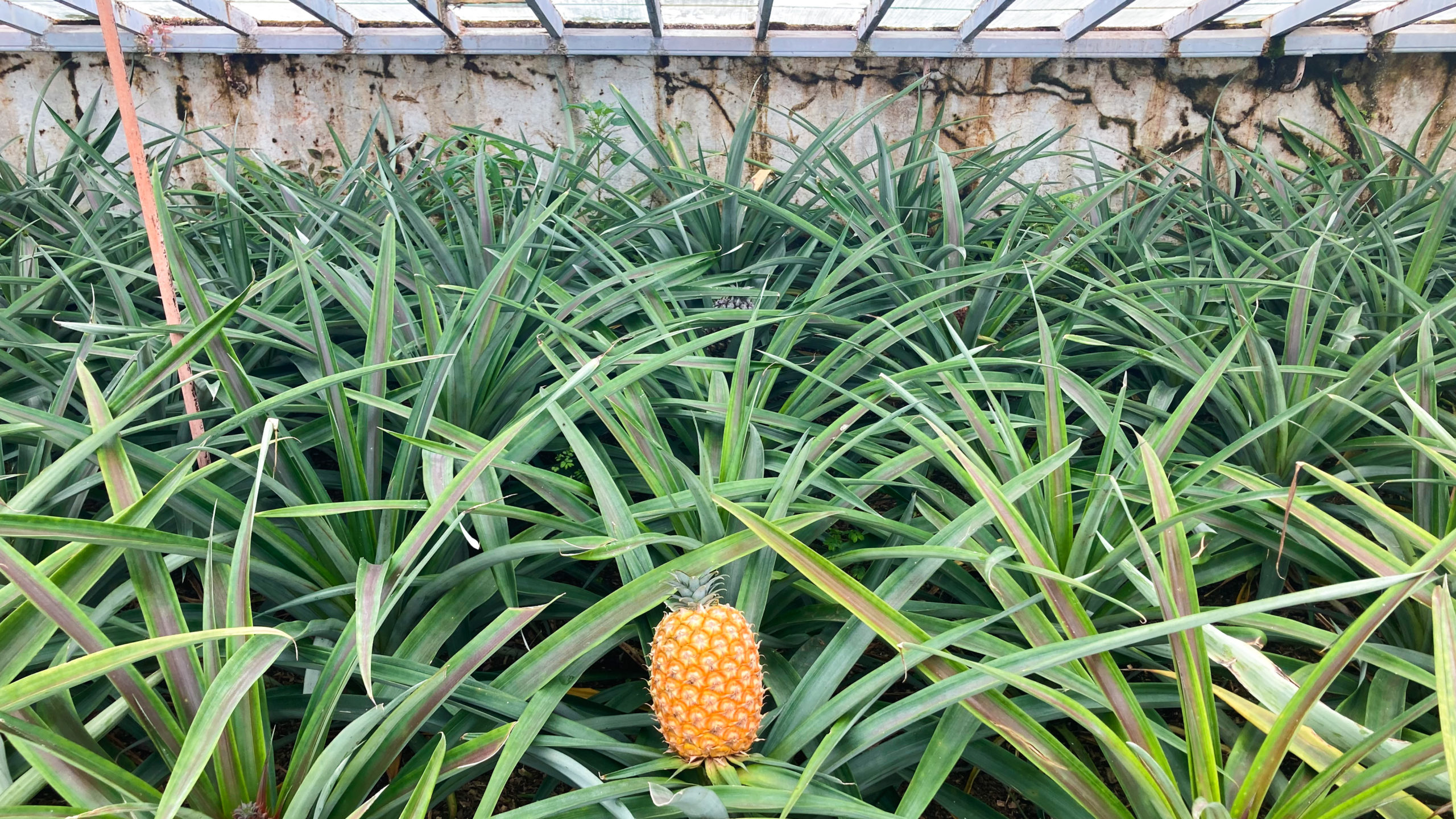
Azorean beverages
Azores Tea
The Azores are home to Europe’s only commercial tea estates. Tea plantations have existed in the island of São Miguel for over two centuries and, all along these years, the production has remained organic. Even though Azorean tea is often synonymous with the brand Gorreana, which even has a public hiking trail going through its plantation and welcomes visitors for complimentary factory tours, it’s worth pointing out that there is one more tea company in the island, Porto Formoso. When the production of orange went into decline in the mid 18th century, locals started looking for new crops that could potentially translate into good business. That’s when tea was introduced and, growing over the years, the Azores now produce over 250 tons of black, green and white tea per year.
If coffee is your cup of tea, you’d be happy to know that in a remote part of São Jorge island, Café Nunes has Europe’s only coffee plantation. This micro coffee plantation in the Azores is located in a fajã, between the Atlantic ocean and massive coastal cliffs that resulted from volcanic eruptions, where everything is done in an artisanal way. Taste Europe’s only coffee during our culinary trips to the Azores.
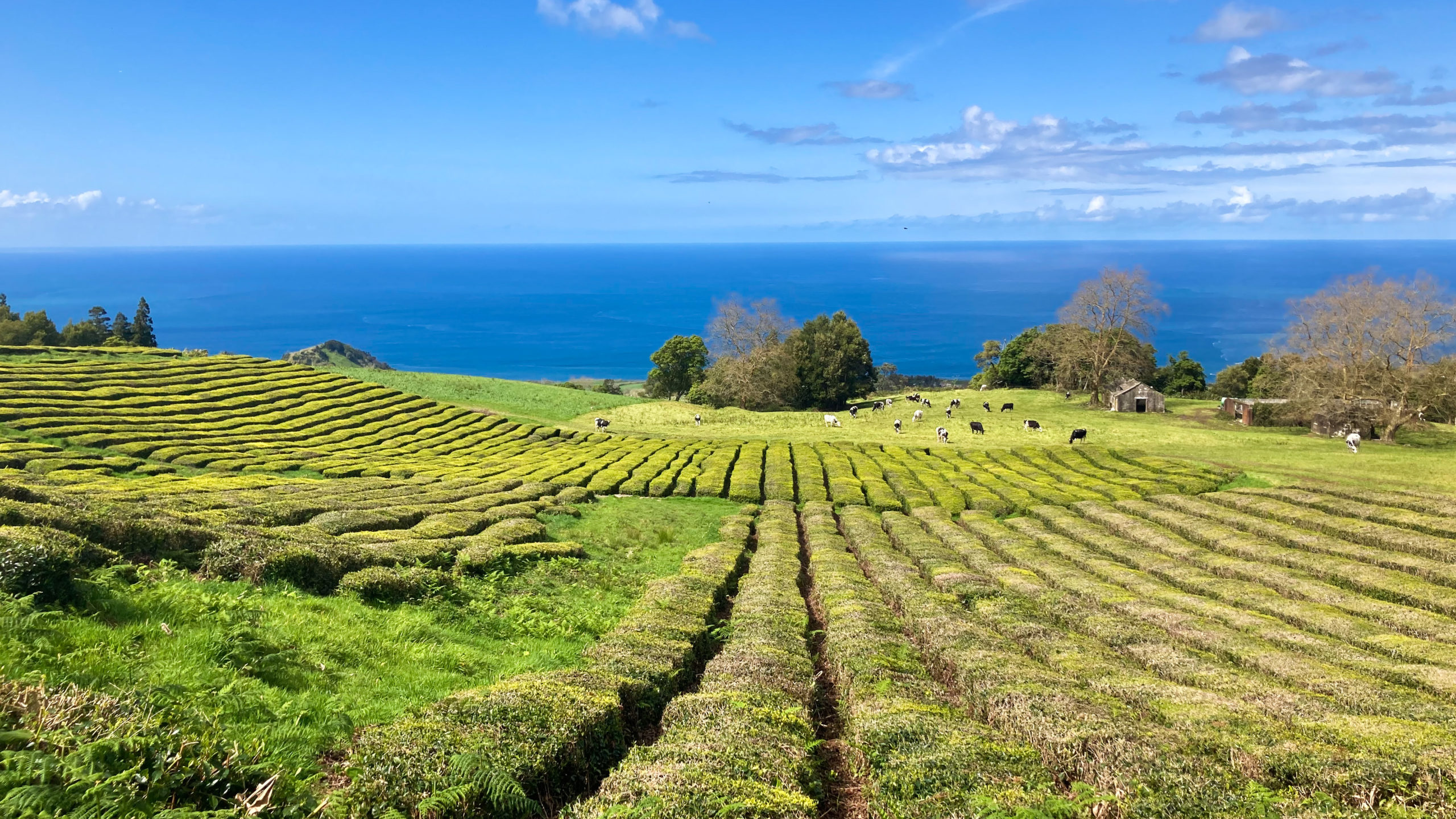
Pico Wine
Speaking about wine from the Azores is an analogue of talking about Pico wine, one of the most distinctive wines in the Portuguese panorama. The wine culture of Pico has been going on for several centuries, focusing on the island’s native grapes: Arinto dos Açores, Terrantez do Pico and Verdelho.
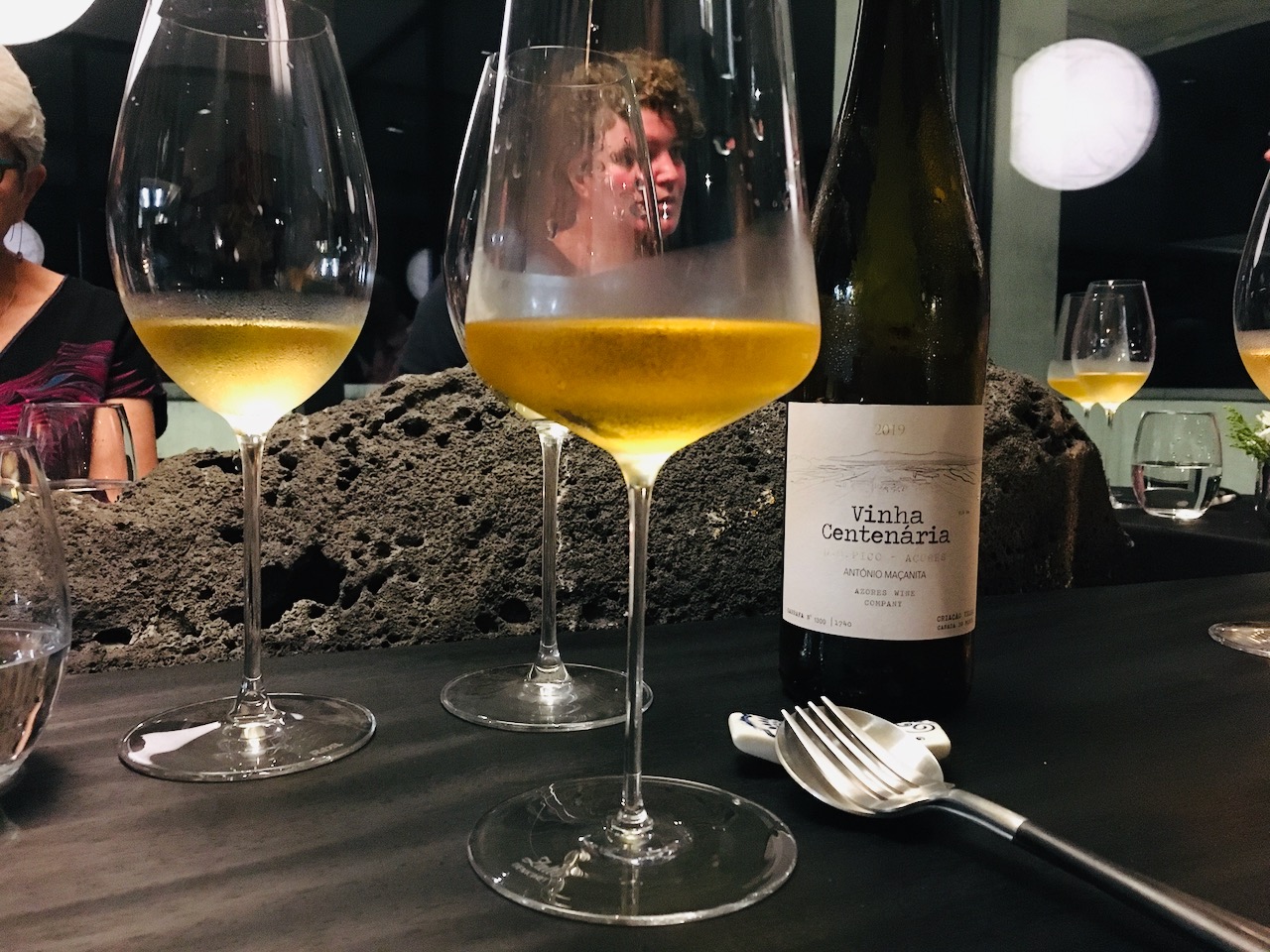 Even though the soil of Pico is made of virtually impenetrable basaltic lava, picarotos, the residents of Pico, managed to grow vineyards structuring their plantations in specific ways that would allow for the plants to grow on tiny areas in contact with the soil, while being protected from the harsh elements by walls of stones that give the landscape of the island a peculiar dark labyrinthic look. There’s no denying that Pico wines are special, taking in the characteristics of their surroundings. Here the white wines are the highlight, with pronounced volcanic notes, noticeable salinity and minerality.
Even though the soil of Pico is made of virtually impenetrable basaltic lava, picarotos, the residents of Pico, managed to grow vineyards structuring their plantations in specific ways that would allow for the plants to grow on tiny areas in contact with the soil, while being protected from the harsh elements by walls of stones that give the landscape of the island a peculiar dark labyrinthic look. There’s no denying that Pico wines are special, taking in the characteristics of their surroundings. Here the white wines are the highlight, with pronounced volcanic notes, noticeable salinity and minerality.
Even though whites are indeed the most recognized wines from Pico, the island also has production of red and rosés and, more importantly, of fortified wines that colloquially amongst locals often simply go by the name verdelho, in reference to the main grape variety used in their production. Even in the aged sweet wines you’ll be able to taste the acidity characteristic of Pico wines as a whole, which is smooth on the palate and with a very persistent finish.
Find out more about Pico wine and dive deep into the island’s wine culture during the Oh! My Cod Pico Experience.
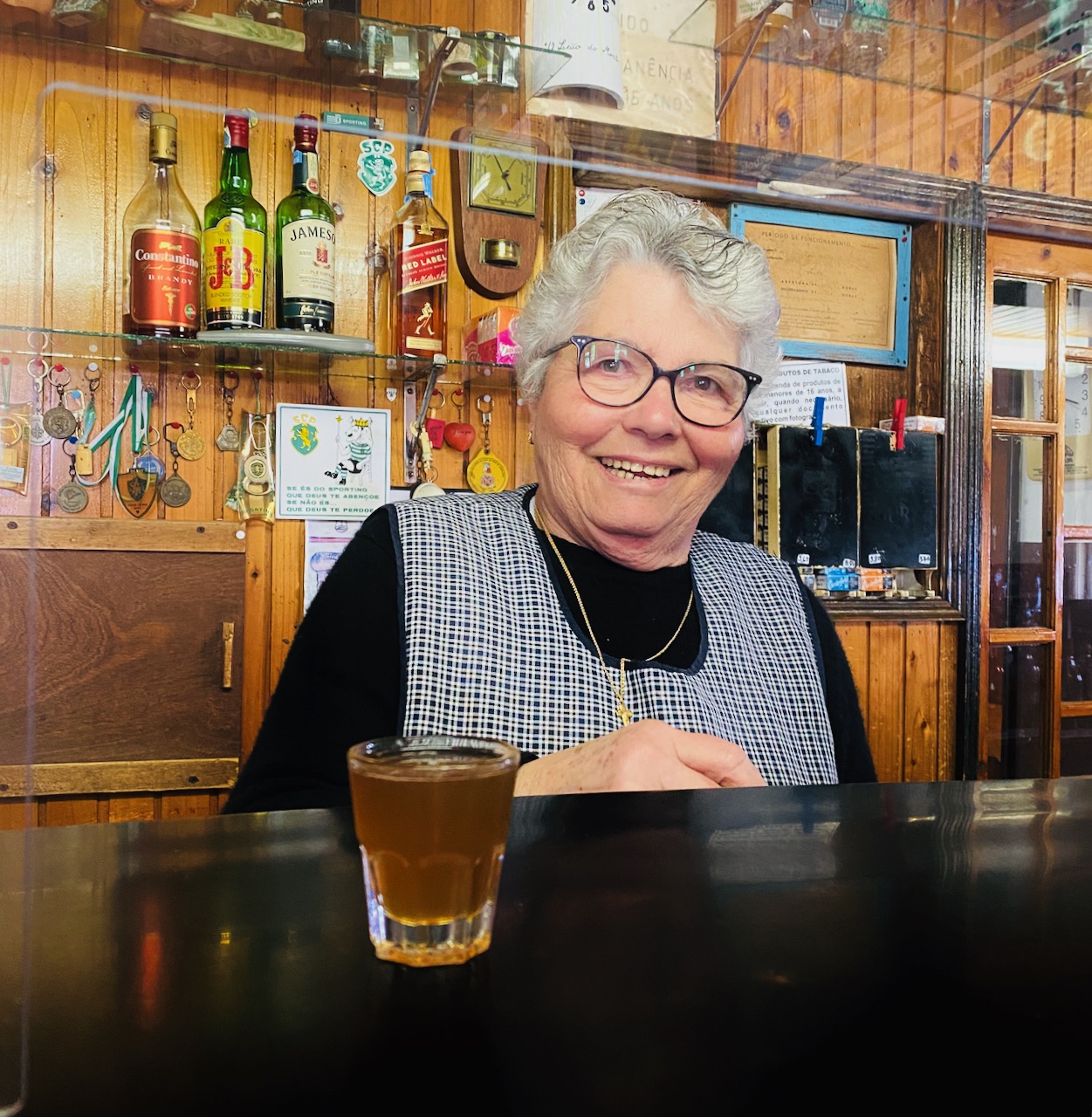
Azorean liqueurs
When you love fruits and drinks, it’s only normal to end up mixing both and, in Portuguese culture, this means producing liqueurs with a variety of flavors. Azorean liqueurs tend to be rather sweet, using aguardente, a Portuguese spirit distilled from wine, as their base. The alcohol is infused with some of the islands’ most popular fruits, such as pineapple, passion fruit and wild blackberry. Besides fruit liqueurs, herb based beverages also abound, such as the cooling licor de nêveda, with catmint, from Pico.
Are you eager to explore the food and wine from the Azores? Join Oh! My Cod Pico Experience and spend a week with us feasting on traditional and contemporary dishes, sampling local ingredients, doing wine tastings, enjoying the stunning nature of Pico island, and making friends with locals and fellow travelers. We would love to break bread and make memories with you!
Article by :
Zara Quiroga (freelance food writer and food & cultural leader at Oh! My Cod Pico Trips)
Photos by:
Sílvia Olivença (anthropologist and food guide/CEO at Oh! My Cod Ethnographic Food Tours & Trips)
Want to more about Portuguese cuisine?
Pico Wine: one of the world’s most unique wine regions (Genesis â Part I)
Alentejo and Algarve: culinary traditions of the South of Portugal
10 Portuguese Codfish recipes step-by-step
Minho, Douro and Trás-os-Montes: the cuisines of Northern Portugal (includes Porto!)

